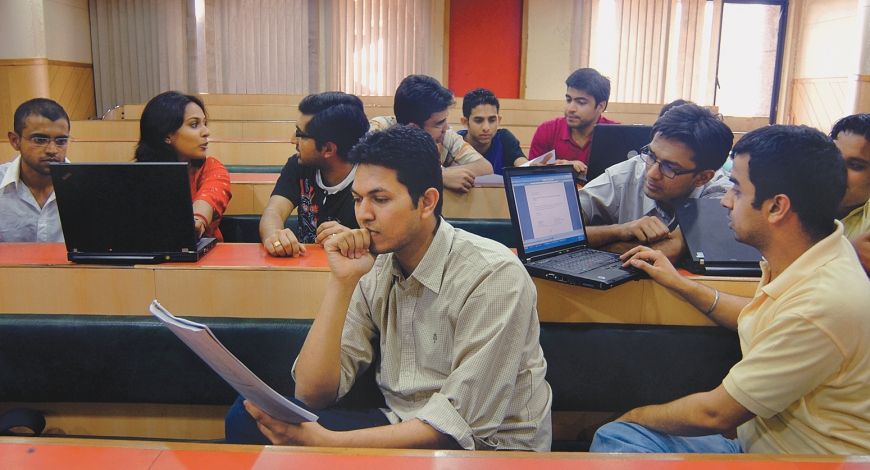Higher Education During COVID and Thereafter: Considerations for India and the Developing World

COVID-19 has emerged as a humanitarian crisis that has ubiquitously impacted almost everything. The uncertainty precipitated by the pandemic is beyond the statistical estimations. Efforts to reinstate the normality of the world order are on its progress through experiments, researches, and cooperations. The ultimate success in the fight against COVID-19 can have positive results only after the invention of a vaccine or drug. Meanwhile, the option is to maintain social distance and adhere to other preventive strategies.
However, this crucial testing time has brought ample opportunities for innovations and the appropriate use of available mechanisms, which many thought difficult to be implemented earlier. A promising shift we could see is in the field of higher education, though the magnitude of such efforts is a concern in the developing world. In India, the Ministry of Human Resource Development (MHRD) and University Grants Commission (UGC) directed the higher educational institutions (HEIs) to use virtual platforms for the teaching-learning process amid the lockdown. Several HEIs throughout the country have initiated online teaching modalities, many for the first time. Conversely, the question is what is the state of implementation of these efforts across the region and what factors are impacting it? Trends from different parts of the country indicate that such efforts are grim at the implementation level.
Except, some of the HEIs in the government, as well as in the private sector, and other institutions are not well equipped to manage the virtual learning platforms. Many HEIs don’t have the infrastructure and technological landscape for the implementations of the online learning process. A large number of teachers and students have never attempted online teaching-learning modalities. The abrupt implementation of the same has created confusion and uncertainty among the students as well as teachers. The HEIs which already have the component of online learning modalities were not affected much by the lockdown and learning from the distance. However, the reality is that such institutions are minuscule in number in India and the developing world.
The dismal fact evident amid COVID-19 is that a large proportion of the HEIs in India and the developing world is not prepared to materialize the educational technologies which have been well utilized in other parts of the world. On the other hand, many educational institutions haven’t used such measures even after having their learning management systems (LMS) appropriately for the teaching-learning process. Instead, preference was for the conventional method of teaching and assessment. The case of colleges is again critical, where the infrastructural and technological factors potentially remain as constraints. The declaration of lockdown and subsequent directions of the government on continuing the teaching-learning activities in the online mode has created confusion among most of the HEIs in India. The estimates also underline that most of the HEIs conducting online classes don’t have promising participation of students. Certainly, some of the premier institutions in the government and private sector are exemptions.
Let’s look at what act as the impediment for engaging students in the virtual platform at this crucial time apart from the institutional and infrastructural constraints. Inevitably, the socio-economic and regional factors play a pivotal role in accessing and affording online platforms. Students belong to rural localities can’t think of high-speed internet connection to attend the live interactive sessions organized by the faculty from a distant place. Colleagues of different universities and colleges across the country also underline the same issue of access and major impediment for online engagement. Is this the only hindrance we face? The answer is no. A large section of the students who are already at the poverty line is deprived of the hardware, gadgets and devices to access such facilities. Thus, the efforts currently available are largely accessible for the elite and middle-class students from the cities and towns with minimal participation of socio-economically disadvantaged students.
Attending lectures online remains a dream for thousands of students who belong to the rural and tribal belts of the country and region with minimal internet connectivity. The same fact of diversity of students, especially in the publicly funded HEIs is the prominent reason for the lower level of participation. Amid the lockdown, there were proposals for conducting exams in the online mode, and few already have experimented the same. However, recent indications from government bodies in India underline distant possibilities of such measures considering the infrastructural and students related factors. Many teachers from public universities also have raised concerns over the idea of conducting online examinations. Indeed, it is a difficult task to implement in India as of now due to technological factors and students’ diversity.
Undoubtedly, COVID-19 remains an uncertainty now. There are no clues yet how further courses of action to be planned for future academic activities. Applet educational bodies and HEIs are seriously working on the revisions of the academic calendar and other mechanisms to sustain the learning activities. What can we learn from this pandemic, specifically for higher education? How can we equip the HEIs to face similar circumstances in the future or otherwise to improve the quality of education? The solution is twofold, technological, and socio-economic.
Attending lectures online remains a dream for thousands of students who belong to the rural and tribal belts of the country and region with minimal internet connectivity.
Firstly, technology integration is essential in teaching-learning and its management. The attempts manifesting now in the arena of online teaching should not be an interim arrangement. The spirit should be sustained and integrated into the mainstream learning process. The use of online spaces doesn’t only mean online teaching; rather, it is a broader idea, where the entire delivery and learning is to be managed by the LMS, including assessment. It is time for seriously working on the revision of the current assessment mechanisms, which have more focus on end term examinations with inadequate continuous assessment.
LMS and other virtual platforms can be better utilized for continuous assessments that are more practical, field-based, and application-oriented, which enriches the critical and creative thinking of the students. Stepping into such measures should also accompany 1) proper orientation of students and teachers, 2) ensure the originality of the students’ works, and 3) appropriate assessment mechanisms. In essence, blending conventional methods with the online platform can yield a better learning experience for the students.
Secondly, the governments and HEIs in the developing world should focus on empowering the socio-economically disadvantaged students. Supports in the form of scholarships and assistance should be provided to such students for purchasing and accessing electronic devices that facilitate learning in a blended manner. The universities and colleges should also enhance such facilities proportionate to the number of students. Attention should be given to maintain regional balance, especially for the HEIs located in the rural and tribal belts in the form of enhanced funding.
The current crisis we are encountering, as a result of COVID-19, should enable the appropriation of the current system of delivery and assessment in higher education. Technology integration, undeniably, remains essential for the modernization of education in India and other countries in the developing world. At the same time, such efforts should take into consideration of socio-economic factors, including region-specific issues and student diversity.



























































































